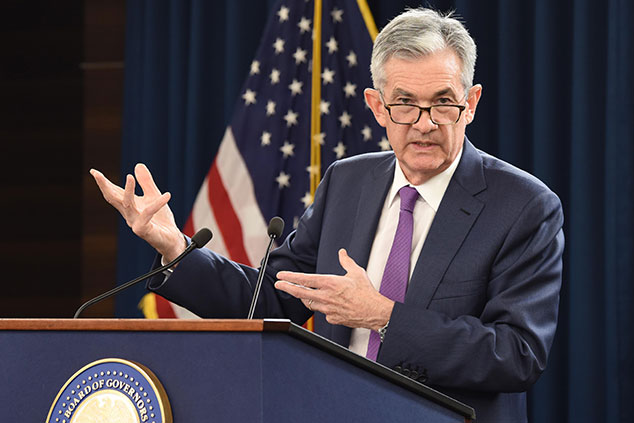
This article is taken from our FREE daily investment email Money Morning.
Every day, MoneyWeek’s executive editor John Stepek and guest contributors explain how current economic and political developments are affecting the markets and your wealth, and give you pointers on how you can profit.
In this week’s issue of MoneyWeek magazine
●
How to invest for Brexit – whatever the outcome
●
Why you should seek out family-run firms
●
Investing in longer lives will lift your portfolio
●
A new ESG investment trust
●
Beware of online property auctions
● Share tips of the week
Not a subscriber? Sign up here
The central bank “put” has been a fundamental component of global financial markets for about 30 years now – roughly the same length as the bond bull market in fact.
A “put” is a term from the world of options trading. A put is an option that gives you the right (but not the obligation) to sell an asset at a set price within a set time period. In other words, a put option gives you some protection against a falling market.
The assumption that central banks will always step in to put a floor under markets is something that investors have come to rely heavily on in recent years.
Now they’re hoping that Federal Reserve chairman Jerome Powell will follow in the footsteps of his predecessors.
But will he?
The history of the central bank put
Central banks have been bailing markets out virtually since they were created – the main purpose of a central bank is to prevent the banking system from going under.
However it was Federal Reserve chairman Alan Greenspan who turned market protection into an art form. Under Greenspan, the Fed became a sort of “market whisperer”. When investors showed any sign of being skittish, Greenspan would cut interest rates to make them feel better. No emergency was too small.
It’s hard to tell in retrospect what Greenspan thought he was doing. But it’s probably no more complicated than the fact that it’s nice to give people good news and then get patted on the back for it.
His reputation is far more chequered now (he cops, and deserves, a lot of the blame for the financial crisis) but back in the day he was known as the “Maestro”. When people are worshipping you, it’s hard to dissent.
Anyway, this mollycoddling was continued under Ben Bernanke and then under Janet Yellen. And no wonder – after the 2008 crisis, the sense of walking on eggshells was enormous.
Throw in the propensity of people in power to imagine that the masses are only ever one big tantrum away from turning into mobs roaming the streets of a dystopian wasteland, and you have a recipe for treating investors with kid gloves.
As a result of all this, interest rates were kept low, the money printing lasted for far longer than anyone imagined, and we’ve had a long, slow recovery with plenty of mal-investment (investment in projects that can’t hope to pay for themselves once funding is withdrawn) along the way.
So that’s the backdrop. Markets grew used to being picked up every time they fell on their backs, so they took bigger risks than they otherwise would have. That’s called moral hazard, and it’s a key driving force – if a much-derided one – of financial market behaviour.
The Fed doesn’t have to offer much more than crumbs
But what about today? Fed chair Jerome Powell appears to be made of sterner stuff than Janet or Ben or Alan. The October slide in markets went by and he didn’t blink.
That has investors rattled. Jim Cramer, CNBC TV personality and probably the best-known stockmarket commentator in the world, last week argued that Powell still had time to “save the economy”.
“Is it too late? Yes, if we get four more hikes. Absolutely. No if we only get one and we wait.”
Cramer reckons he spotted some signs of wavering at a speech the central bank boss made last week, in which Powell acknowledged that slowing global economic growth was “concerning”. And he’s milking that hope for all it’s worth.
“Powell knows now that normalising interest rates isn’t the goal – no one knows what normal is these days anyway.”
Is Powell in the mood to listen to the anguished cries of investors, personified in Cramer? We’ll find out later this week.
Tomorrow, Powell talks at the Economic Club of New York. Whatever he says there will be pored over for hints that the Fed might slow down or even stop the rate of raising interest rates.
The excuses are there if the Fed feels that it needs them. As I’ve already noted elsewhere, falling oil prices would certainly give the Fed cover to feign more relaxation about inflation. Also, the US dollar’s recent and current strength also reduces inflationary pressure.
There’s the question of “face” – how does Powell walk back his tough guy act without losing credibility? But he doesn’t need to say much. Markets are desperate for some crumbs of comfort, so that’s all he needs to offer. If he hints at some leeway, they’ll lap that up.
Overall, Steven Blitz of TS Lombard argues that the Fed is likely to tread a middle path. The next big meeting is on 18 and 19 December. They will raise rates as planned, but they will adjust the “forward trajectory for policy rates”. In turn, that could “cause the dollar to fall some, and in turn, help stabilise the US and global economies”.
A nod towards looser monetary policy would likely set us up for a Santa Claus rally. But let’s see what he says first.